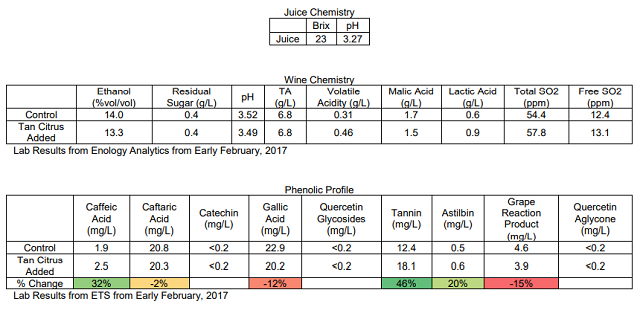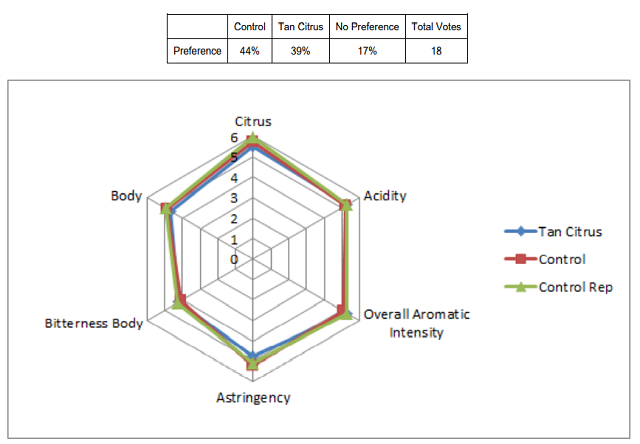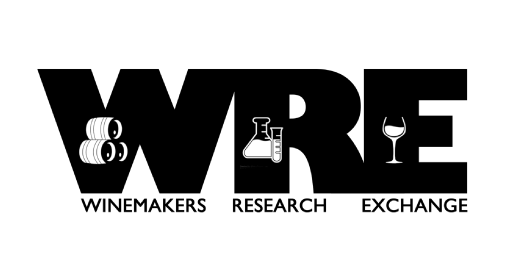The Effect of Tan Citrus on Petit Manseng (2016)
Seth Chambers
The Winery at La Grange
Summary
This study compares Petit Manseng wine fermented either with or without the enological tannin Tan Citrus (Enartis) added before primary fermentation. When combined with yeast with β-glycosidic activity, this tannin may increase fruit and floral aromas in wine. The yeast used in this study was 58W3, a glycosidic yeast. No major chemical differences were found between wines. Wines made with Tan Citrus had higher tannin content and slightly lowered grape reaction product, which may suggest that Tan Citrus helped protect the wine against oxidation. Triangle sensory testing revealed that the wines were significantly different (p<0.001). No major sensory trends could be seen with the descriptors used in this study, and judges were split on which wine they preferred.
Introduction
Enartis Tan Citrus is a fermentation tannin which is extracted to preserve naturally occurring aromatic compounds in the wood such as norisoprenoids and terpenes. In general, fermentation tannins are supposed to help protect wines against oxidation. This tannin, when used in combination with a β-glycosidic yeast, may enhance aromas of white and rosé wines (due to these aromatic precursors being glycosidically bound) (Enartis 2011). In this study, Petit Manseng was fermented with and without the presence of Tan Citrus. A glycosidic yeast was used as well.
Results and Discussion
No major chemical differences were found between wines. Wines made with Tan Citrus had higher tannin content and slightly lowered grape reaction product, suggesting that this product may have helped protect the wine from oxidation.

The wines were tasted on March 8, 2017. For the triangle test, of 30 people who answered, 19 people chose the correct wine (63%), showing a statistically significant difference between wines (p<0.001). These wines were voted to have an average degree difference of 4.5 (out of 10), suggesting that the wines were moderately different. In general, people who answered correctly did not have a preference for either wine. Much of the comments were mixed, but some judges commented that the Tan Citrus wine seemed to have a cleaner flavor. No strong trends were found between wines with the descriptors used in this study. No general trends could be seen between treatments as well.

Methods
Estate-grown Petit Manseng was harvested on 9/22/2016 and whole cluster pressed. Grapes were processed on the following day. Cinn Free was added to the grapes before pressing, and 30ppm sulfur dioxide was added at the press tray. The juice was then cold settled at 55 degrees for 48 hours, and then split into 2 identical 70 gallon barrels (only 65 gallons were transferred). Each barrel then received 30g/hL Booster Blanc, 15g/hL FT Blanc Soft, and 30g/hL Optimum White. The barrels were inoculated on 9/26 with 58w3 yeast, a glycosidic yeast in order to better bring out the qualities of Tan Citrus and fermented in barrel. After ⅓ Brix depletion, Tan Citrus was added at the recommended dose to a treatment barrel while the control did not have Tan Citrus added. Fermaid K was also added at ⅓ Brix depletion to both barrels. Prior to taking wine for the research exchange (late January), the wines were stabilized with 38ppm sulfur dioxide.
For the triangle test and preference analysis for the March 8 tasting, anybody who did not answer the form were removed from consideration for both triangle, degree of difference, and preference. Additionally, anybody who answered the triangle test incorrectly were removed from consideration for degree of difference and preference. Additionally, any data points for preference which did not make sense (such as a person ranking a wine and its replicate at most and least preferred, when they correctly guessed the odd wine) were removed.
In order to balance the data set to perform statistical analysis for descriptive analysis on the March 8 tasting, any judge who had not fully completed the descriptive analysis ratings were removed. In order to then make the amount of judges between groups equivalent, one judge from group 1 was eliminated. This resulted in a final data set of 3 groups, each with 10 judges (considered as replications within groups, and groups were considered as assessors). Data was analyzed using Panel Check V1.4.2. Because this is not a truly statistical set-up, any results which are found to be statistically significant (p<0.05) will be denoted as a “strong trend” or a “strong tendency,” as opposed to general trends or tendencies. The statistical significance here will ignore any other significant effects or interactions which may confound the results (such as a statistically significant interaction of Judge x Wine confounding a significant result from Wine alone). The descriptors used in this study were Citrus, Acidity, Overall Aromatic Intensity, Astringency, Bitterness, and Body.
References
Enartis. 2011. Enartis Tan Citrus: Blend of enological tannins specifically intended for protection against oxidation and increased fruit aromas of white and rosé wines. shop-usa.enartis.com/amfilerating/file/download/file_id/7. Accessed 5/9/2017.
